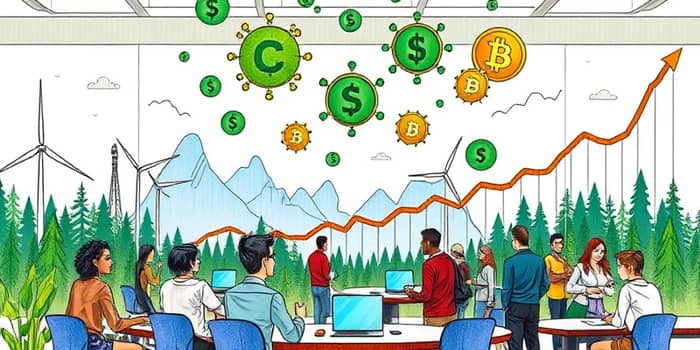Over the past four decades, the notion of carbon credits has evolved from a niche environmental policy instrument into a dynamic financial asset. What began as pilot programs under the Clean Air Act has matured into a market that now transacts trillions of dollars annually, shaping corporate strategies and global climate action.
This transformation reflects decades of market-based environmental regulation and international cooperation. Understanding this journey offers both inspiration and practical guidance for investors, policymakers, and corporations seeking to harness carbon markets for positive impact.
From Regulatory Experiments to Market Mechanisms
The origins of tradable emissions rights trace back to the late 1970s in the United States. Amendments to the Clean Air Act empowered regulators to allow offsets when companies reduced pollution in one location to compensate for increases elsewhere. This approach laid the groundwork for the comprehensive Acid Rain Trading Program launched in the 1990s.
By establishing a cap on sulfur dioxide emissions and permitting the trading of allowances, the Acid Rain Program demonstrated the power of economics in driving environmental outcomes. Companies that innovated to reduce their own emissions reaped financial rewards by selling surplus credits, illustrating the concept of financial value for emissions.
Global Frameworks and the Rise of Compliance Markets
The Kyoto Protocol in 1997 marked a landmark moment, creating the first international compliance carbon markets. The Clean Development Mechanism (CDM) allowed developed nations to fund emission-reducing projects in developing countries and earn tradable credits in return. This architecture not only facilitated global collaboration but also set the stage for carbon as a commodity.
Fast-forward to the Paris Agreement in 2015, and virtually every nation committed to Nationally Determined Contributions (NDCs). These pledges catalyzed new market instruments and cooperative mechanisms. The momentum continued at COP29 in 2024, where clear rules for credit registration and trading bolstered confidence in both compliance and voluntary schemes.
How Carbon Trading Works in Practice
At its core, each carbon credit represents the right to emit one ton of carbon dioxide or an equivalent amount of greenhouse gas. Under cap-and-trade systems, regulators set an overall emissions cap and distribute allowances. Companies that reduce emissions below their allocation can sell excess allowances to those facing deficits.
This simple supply-and-demand dynamic gives rise to a robust derivatives market supporting liquidity, enabling futures contracts, options, and other instruments that deepen market access and risk management.
Market Evolution and Institutionalization
By the late 2010s, carbon credits were no longer confined to government-regulated systems. Major exchanges like the EU Emissions Trading System (EU ETS), the Regional Greenhouse Gas Initiative (RGGI), and the Western Climate Initiative (WCI) collectively recorded over $250 billion in trading value by 2019. Around $1 billion changes hands daily, reflecting growing liquidity.
Institutional investors have recognized carbon credits as an innovative climate-risk hedging asset. Funds and endowments allocate to exchange-listed products, private carbon portfolios, and derivatives linked to benchmark allowances. This has elevated carbon credits to an officially recognized asset class, complete with governance frameworks, rating agencies, and standardized reporting.
- Net-zero corporate commitments driving demand
- Regulatory reforms enhancing market integrity
- Emerging national programs in Asia and Australia
- Technological advances in blockchain and tokenization
Opportunities and Challenges Ahead
The projected growth of the carbon credit market is staggering: analysts forecast a $1.96 trillion expansion from 2024 to 2029, driven by a 32.1% CAGR. Demand is expected to multiply fifteenfold by 2030, fueled by net-zero targets and investor appetite for trusted standards and rating services.
Yet challenges persist. Credit quality, double-counting, and inconsistent methodologies threaten both environmental integrity and market confidence. Harmonization efforts at the international level strive to establish unified protocols, while voluntary market initiatives seek to increase transparency.
- Ensuring rigorous project validation and verification
- Preventing overlap between compliance and voluntary credits
- Standardizing measurement and reporting frameworks
Best Practices for Engaging with Carbon Markets
Whether you’re a corporate sustainability officer or an institutional investor, engaging effectively with carbon markets requires strategy and diligence. The following guidelines can help you navigate this evolving landscape:
- Assess portfolio exposure to carbon-transition risks
- Partner with reputable project developers and verifiers
- Adopt recognized standards such as the Gold Standard or VCS
- Monitor regulatory developments and adjust allocations
- Leverage digital platforms for real-time market data
Charting the Course for 2030 and Beyond
The story of carbon credits illustrates how environmental policy can intertwine with financial innovation to drive global impact. As markets mature, we anticipate further integration of innovations and emerging products, including nature-based solutions, carbon removal technologies, and digital tokenization.
For decision-makers, the path forward involves combining rigorous environmental safeguards with sophisticated market instruments. By aligning economic incentives with sustainability goals, carbon credits can continue to serve as a critical lever in the race to net zero.
Ultimately, embracing this asset class offers more than financial returns—it represents a collective investment in the planet’s future. With careful stewardship, transparent governance, and strategic engagement, carbon credits will remain at the forefront of climate action, transforming ambition into measurable results.
References
- https://carboncredits.com/the-ultimate-guide-to-understanding-carbon-credits/
- https://rpc.cfainstitute.org/research/reports/case-study-carbon-as-emerging-asset-class
- https://en.wikipedia.org/wiki/Carbon_offsets_and_credits
- https://www.globenewswire.com/news-release/2025/01/31/3018838/28124/en/Carbon-Credit-Industry-Report-2025-2029.html
- https://www.arbonics.com/knowledge-hub/a-little-history-of-the-voluntary-carbon-market










